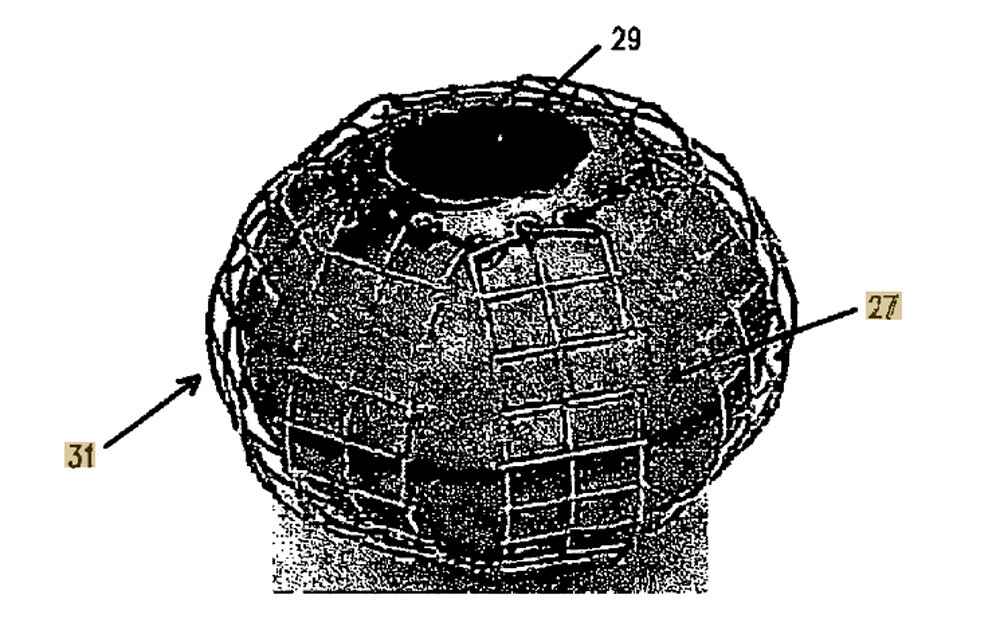5 Mad Weapons That Change the Rules of What’s Possible

Everyone should own a collection of weapons, to protect themselves from looking well-adjusted. The appeal of this arsenal has nothing to do with genuinely wanting to hurt anyone in particular. Instead, you’re fascinated by these tools’ power and weirdness. For that reason, we recommend dispensing with the swords and guns hoarded by your typical vanilla nutcase. Instead, seek out such out of-the-box solutions as...
Rods From Up in Space
The very first weapon (and the first bit of technology, period) was probably a rock that one human threw at another. We moved from there to hurling more sophisticated types of rocks, in increasingly elaborate ways. Later, we realized we could attack each other much more forcefully using the power of explosives. But in the 1950s, Boeing engineer Jerry Pournelle proposed going back to a projectile that used no explosives, just pure kinetic energy. The difference here is these projectiles would come from straight above.

We’d keep a satellite in low Earth orbit, and we’d stock it with tungsten cylinders, 25 feet tall and 2 feet wide. Then when we finally lose patience with our enemies, we drop the rods to Earth, and they hit Toronto at 7,000 miles per hour. Pournelle dubbed this “Project Thor,” while other people have called it “Rods from God.” The cylinders would strike like a nuke but without any radiation.
Some defense experts have questioned the benefits of such a weapon. If we wanted to launch tungsten missiles, we could do so from the ground. Pournelle was using his imagination as a sci-fi writer rather than engineer’s prudence, argue these naysayers. This may be true, but the imagination here is the point. Rods from space would be cool; how do they not understand this?
Also, while nations have signed treaties banning certain types of weapons from space, these treaties say nothing about kinetic bombardment. Meanwhile, if you yourself launch rods from space, as a private citizen, no country even has jurisdiction over you to prosecute you — and if they claim they do, you can just drop a tungsten rod on them.
Power-Sapping Dust
Picture a bag of ground-up graphite. It’s quite useful for lubricating locks and for leaving stains on wooden parts of your home. Throw it at someone’s face, and you can make them look like a coal miner, and also feel like a coal miner, because it will choke them.
Now, let’s think bigger. We launch this graphite from a plane onto a target. Here, we rely not on graphite’s blackness or slipperiness but its conductive nature. The targets are power stations and power lines. Coated with clouds of this conductive powder, the electrical system breaks out with short circuits, everywhere. One day in May 1999, NATO tried spraying this graphite across a few strategic locations in Serbia. Instantly, 70 percent of the country lost power.

The graphite bomb is considered relatively non-destructive because we don’t actually demolish any of these electrical facilities. We merely induce short circuits, which can be repaired. It’s also classified as a nonlethal weapon. It’s totally nonlethal, so long as we assume absolutely zero people the country were relying on electricity to stay alive that day.
Lightning on Command
For all our technological progress, the weather remains largely out of our control. We can’t blow apart rain clouds when we want to go out and play; we can’t summon rain clouds when we want to get wet and wild. We have had some success, however, with teasing output from clouds that happen to already be in place. When we see a cloud, we can seed it with dust and then demand credit when rain follows. We do the same thing with hail, teasing baby hailstones out before they get bigger and hit us like tungsten rods.
We can do that with lightning as well, only it’s a harder process. There’s no substance, as far as we know, that we can spray into clouds to coax out lightning bolts. Instead, we launch rockets into clouds, trailing copper wire coated in Kevlar. This electrically connects the cloud to the ground. You know that story about Ben Franklin flying a kite during a thunderstorm to pull electricity down (the story that didn’t actually happen)? This is like that, but with rockets, so it’s even more patriotic.
Rockets trailing miles of wire tend to be unwieldy, and the process also doesn’t always work. So, around 15 years ago, scientists moved to the next logical step: lasers. They fire lasers at clouds, and this creates a channel along which electricity can travel. Electricity travels upward from the ground to the sky, discharging particles in the cloud and setting off a lightning strike — that’s a little-known fact about lightning, by the way; the electricity actually travels upward.

So far, the stated goal of the lightning project has been similar to the hail one: inducing small strikes now to prevent larger ones later. The scientists have to say that, due to pesky international treaties against weaponizing weather. Once they perfect the system, however, we trust they’ll do the right thing and use lightning for its true purpose of destruction and fear.
The Nuclear Rifle
Nukes remain the ultimate weapon, inhibiting the creativity of people everywhere. When a room of people write a blockbuster and ask themselves how to kill an army of aliens, they figure we can nuke the entire city or leave the heroes to fight with pistols and fists from a few yards away — nothing exists between those extremes. Never mind that we had artillery that could strike from 50 miles away more than a century ago.
But what if we could combine the destructive power of nukes with the inconvenience and personal risk of boots on the ground? That was the question answered by the M-28 Davy Crockett Weapon System, a 1960s tool for firing a nuke from a mounted rifle.

It was a teeny nuke, whose explosive impact was measured not in kilotons but tens of tons. That’s because you don’t need more than a teeny nuke to kill everyone within 500 feet. The soldier who fired the nuke would stand well outside that radius, as the rifle could launch its warhead a couple miles. Still, neutron radiation has a habit of drifting wherever the wind blows, so the gunman was advised to take shelter behind a hill.
The army phased out the Davy Crockett by the end of the decade. They reasoned that an individual soldier launching nuclear war could have some downsides.
Balls of Pure Fuel Fly Around at Will
Clearly, you always need to take care over which direction you aim your weapon. But what if you don’t feel like doing that? For people who wish to embrace chaos, we recommend the kinetic fireball incendiary munition. Light this ball of rubberized rocket fuel, and it’ll shoot in some direction or another. After a couple seconds and a couple bounces, you have no idea where it’s headed.

The Pentagon has tested this weapon with the goal of chucking them in some building filled with chemical or biological weapons. Blow the whole building up with a missile, and that may disperse the building’s contents. Toss in a couple rocket balls, however, and they’ll tear up the interior, destroying everyone and everything but leaving the building’s skeleton intact. This is not an explosive weapon but an incendiary one, and the unique ball setup keeps the fire from burning out too quickly.
And what keeps the ball from spinning around and heading toward whoever launched it? Possibly nothing, and this is the ball’s greatest selling point. It’s exciting, you see. If you’re brave enough to wield these, the enemy knows you have some balls.
Follow Ryan Menezes on Twitter for more stuff no one should see.